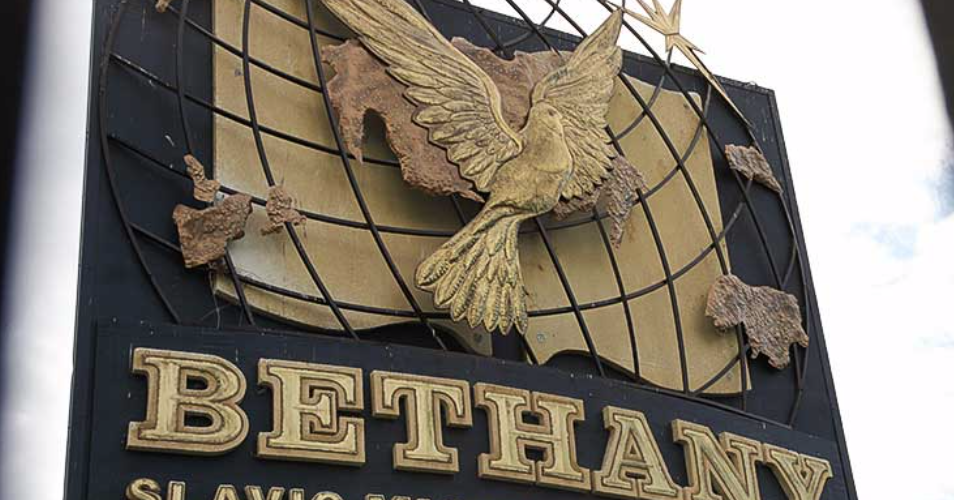It isn’t often that a newspaper does such an awful job on a coronavirus story that it has to run several more stories correcting the initial report.
Let’s work our way through this case slowly.
A few weeks ago, I became aware of stories in the Sacramento Bee that blamed one megachurch for the spread of coronavirus among several dozen individuals. It’s the country’s largest Slavic Pentecostal church and, judging from one of the Bee’s pieces, a center of dangerous activity because of past opposition to gay rights. So when the church is linked to 71 coronavirus infections and one death and counting, it’s game on.
We’ll start with the Sacramento Bee’s initial April 2 piece on the virus’s spread. It had four bylines. What you see here is a second version of the story, which has the church’s response. But the original did not.
One church in Sacramento County is now the epicenter of a major outbreak of coronavirus, and frustrated county officials say church leaders are refusing to listen to their demands to stop fellowship meetings.
Seventy-one members of the Bethany Slavic Missionary Church near Rancho Cordova or people associated with congregation members have been afflicted with the virus, county officials say, making this one of the larger outbreak clusters in the country. One parishioner has died, officials said, and the pastor is sick.
Hmm … that second sentence is a cover-all-your-bases kind of statement. The region’s Slav community, which the Bee says numbers 90,000, is a close-knit one. So to say “people associated with congregation members” throws a pretty wide net.
Bethany is a large church at 3,500 members (but with up to 10,000 attending) but there are actually 103 other Slavic churches in the region. Was Bethany the main source of this problem or were there other churches involved? Or were there ethnic Slavs involved who weren’t members of any church at all?
It’s clear Bethany is a mover/shaker kind of place. Watch this video to see their mass baptisms of full-dressed white-clad folks in a huge pool. However, the Los Angeles Times did a story last year saying that baptismal water was contaminated thanks to a closed Air Force base nearby.
Sacramento health officials say they have made several attempts via phone and in person this week to talk to church leaders, but have been rebuffed. The cases involve residents of Yolo and Placer counties as well.
“They’ve basically told us to leave them alone,” Sacramento County health chief Dr. Peter Beilenson said on Thursday morning. “This is extremely irresponsible and dangerous for the community.”
Beilenson said the church has stopped its weekly main services, but church members have continued to meet in groups in people’s homes for fellowship meetings. Church officials have told a county nurse that those meetings are important in their community.
Sounds very bad, no? The problem is the wording of that paragraph discussed earlier, which puts the onus on the church. The 71 sick, we will find out later, weren’t necessarily church members. They may have been Slavs but not Pentecostals.
Now the newspaper got that 71-member figure from the county, and it sounds like the county made some major assumptions that all 71 were members of this church. In other words, the church was masterminding this rebellion somehow and the newspaper didn’t question them on it.
Part of the mix is that that these Slavs may be not as tech-savvy and internet-fluent in American culture as they should have been. Services at this church are in Russian as well as English and the pastor himself was hospitalized, which no doubt added to the confusion.
Near the end, there was a truly idiotic quote:
Ruslan Gurzhiy in a Thursday interview with The Bee said he spent seven years as a volunteer at Bethany Slavic. He said members of the Sacramento Slavic community are “really religious.”
“The only place to gather, for them, is the church,” he said.
He also pointed out a major sanitary concern related to the church: Bethany Slavic’s special, monthly Pentecostal services involving mass sharing of church wine.
“There are 3,000 people drinking from a couple of chalices. They drink from one chalice — all hundreds of people.”
Could that “sharing of church wine” be Holy Communion, Christianity’s most ancient and sacred rite?
If so, why didn’t the reporter say so instead of making the church sound like a vodka fest?
The story got distributed to other media, such as the Los Angeles Times, which had this headline: “Pentecostal church in Sacramento linked to dozens of coronavirus cases” even though there was no response from the church.
First lesson in covering this kind of controversy: Don’t run the story until you have some reaction from the main player. The end result? Some of the original facts were wrong and The Bee spent several articles trying to clean up the mess.
On April 3, the church put out a press release saying it had closed its doors March 18, taken all meetings online and refuted most of the major points in the original Bee article. It had not rebuffed county officials, it said; the county had not sent them any written communication asking to talk and it certainly hadn’t told any officials to “leave us alone.”
The Bee’s second version of the story ran the church’s statement saying church meetings had stopped two weeks before and that the church wasn’t condoning or organizing this. The uproar might have stopped there except for this story the Bee ran on April 4.
Bethany Slavic Missionary Church doesn’t shy away from controversy.
The giant Pentecostal church near Rancho Cordova, one of the cornerstones of the Sacramento area’s Eastern European immigrant community, injected itself into a fierce and borderline violent debate over gay rights more than a decade ago, earning rebukes from elected officials and scorn from the gay community over its tactics.
Last year, its members participated in protests at the state Capitol against a bill that strengthened California’s vaccination laws. And now Bethany Slavic and its 3,500 members have found themselves accused by Sacramento County health officials of blatantly violating the stay-at-home orders designed to slow the spread of the coronavirus.
Notice the loaded wording here: “Blatantly.” “Borderline-violent.” Doesn’t sound like a nice place.
On April 8, the Christian Post waded into the story and quoted from Bethany’s press release, which mentioned TV stations running archived footage of Bethany’s services in a way that made it seem as though such services were still going on.
The Bee ran another story on April 9; two-byline piece on how the county and church have agreed to work together. Church maintained they were always working with the county.
A week after criticizing a Sacramento-area Slavic church as an epicenter for COVID-19 cases, county health officials said Thursday they held a productive phone call with church leaders on working together to stem the spread of coronavirus in the Slavic community.
Leaders of Bethany Slavic Missionary Church initiated the 45-minute conference call, which took place on Wednesday, county spokeswoman Janna Haynes said. The county said the call marked the beginning of a “collaboration” to reach members of the region’s massive Slavic community with messages about the virus.
“We’re looking to them to help us continue to build trust in that community,” Haynes said.
The county also hopes Bethany Slavic, on a large campus near Rancho Cordova in southeast Sacramento County, will reopen its food bank, which the church said it closed in the face of public criticism of the church’s activities.
That last bit is an interesting detail. The church got tons of bad PR on this one. We continue:
A joint county and church statement issued on Thursday noted that there is a large outbreak of COVID-19 in the Slavic community, but not all positive cases are members of the church. The 3,500-member church’s founder and lead pastor, the Rev. Adam Bondaruk, 76, and his wife, Galina, are among those infected with the coronavirus.
The statement concluded: “Sacramento County does not condone ridicule, hatred or violence toward this church, our Slavic residents and Slavic health care workers on the front lines of this public health crisis.”
There’s a lot to learn from this. The county officials may not have known what they were talking about and the newspaper jumped the gun by running a piece without verifying all the accusations leveled by the county.
Lesson 1: Public officials aren’t always accurate.
Lesson 2: Just because a congregation is theologically conservative doesn’t mean its members are crazy.
Lesson 3 could easily be as follows: When dealing with a church whose leader is in the hospital and whose members come from a widely different cultural and linguistic background, double-check your facts. Sadly, immigrants are often suspect, even if they’ve been here for years.
If journalists don’t take that extra care, they may end up having to run multiple stories — as the Bee did — to quote people on the other side of the debate explaining the rest of the facts.












